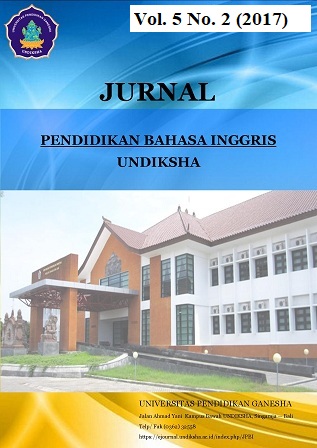POSITIVE AND NEGATIVE REINFORCEMENT USED BY ENGLISH TEACHERS TOWARDS STUDENTS WITH ATTENTION DEFICIT HYPERACTIVITY DISORDER (ADHD)
DOI:
https://doi.org/10.23887/jpbi.v5i2.18431Abstract
Penelitian ini bertujuan untuk menganalisis penguatan yang digunakan guru terhadap siswa dengan Attention Deficiti Hyperactivity Disorder (ADHD) di Aura Sukma Insani Bilingual Kindergarten. Fokus dari penelitian ini adalah jenis reinforcement yang digunakan, respon dari siswa ADHD serta pengaruhnya terhadap perilaku dan hasil belajar dari siswa ADHD. Dalam penelitian ini, penulis menggunakan deskpripsi kualitatif dalam bentuk studi kasus dengan melibatan guru dan siswa ADHD. Objek penelitian ini adalah penguatan yang digunakan oleh guru terhadap siswa ADHD selama proses pembelajaran. Data dikumpulkan dengan melakukan observasi dengan menggunakan lembar observasi, merekam vidio, kuesioner dan wawancara. Berdasarkan hasil analisis data, peneliti menemukan bahwa guru di kedua kelas menggunakan penguatan positif dalam bentuk lisan maupun tindakan, seperti memanggil nama setelah meberikan pujian, memberikan tanggung jawab, memilih siswa ADHD terlebih dahulu, memberikan senyuman, menunjukan jempol, duduk dekat siswa ADHD, melakukan tos dan memberikan stempel. Selain itu, penggunaan penguatan negatif, seperti memberikan peringatan, pilihan, menunjukan gerak/isyarat dan mengambil beberapa barang yang hasilnya didukung oleh persepsi dari guru yang menyatakan bahwa penguatan memberikan pengaruh terhadap perkembangan sikap yang baik serta kemampuan siswa ADHD selama proses pembelajaran.Kata Kunci : Hasil belajar, penguatan, perilaku, siswa ADHD
This study aimed to analyze the reinforcement used by teachers towards student with Attention Deficit Hyperactivity Disorder (ADHD) at Aura Sukma Insani Bilingual Kindergarten. The focus of this study was the types of reinforcements, the ADHD students’ responses, and its impact towards the ADHD students’ behavior and learning outcomes. This study used descriptive qualitative in the form of case study by involving the teachers and ADHD students. The objects of this study were the reinforcements used by the teachers towards the ADHD students during teaching and learning process. The data were collected by conducting observation with observation sheets, video recording, questionnaire, and interview. Based on the result of data analysis, it was found that the teachers used positive reinforcement both verbal and non-verbal, such as calling name after praising, giving responsibility, choosing ADHD student firstly, giving smile, showing thumb up, sit near ADHD students, high-five and giving stamp. Moreover, the negative reinforcements were giving warning, giving choice, showing gestures and taking things in which supported with the teachers’ perception which stated that reinforcement could give impact towards the improvement of the good behavior of ADHD students, included with their ability in learning during teaching and learning process.
keyword : ADHD students, behavior, learning outcomes, reinforcement
Published
2019-07-15
Issue
Section
Articles
License
Authors who publish with the Jurnal Pendidikan Bahasa Inggris Undiksha agree to the following terms:- Authors retain copyright and grant the journal the right of first publication with the work simultaneously licensed under a Creative Commons Attribution License (CC BY-SA 4.0) that allows others to share the work with an acknowledgment of the work's authorship and initial publication in this journal
- Authors are able to enter into separate, additional contractual arrangements for the non-exclusive distribution of the journal's published version of the work (e.g., post it to an institutional repository or publish it in a book), with an acknowledgment of its initial publication in this journal.
- Authors are permitted and encouraged to post their work online (e.g., in institutional repositories or on their website) prior to and during the submission process, as it can lead to productive exchanges, as well as earlier and greater citation of published work. (See The Effect of Open Access)













